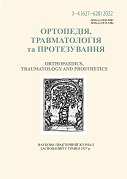Mathematical modeling of the acetabulum fracture (type 62-B1.3 by AO/ASIF) deformities and hip endoprosthetics in combination with osteosynthesis
DOI:
https://doi.org/10.15674/0030-598720223-439-44Keywords:
Mathematical modeling, acetabulum, fracture, endoprosthesis, osteosynthesis, deformationAbstract
Secondary degenerative disabling changes in the hip joint often develop in the long term after surgical treatment of hip fractures. A well-founded differential approach to the selection of endoprosthesis components and additional means of stabilizing bone fragments is necessary. Objective. To investigate changes in relative deformation values in a hip joint model with a acetabulum fractures 62–B1.3 type by AO/ASIF classification under the conditions of its endoprosthesis using various osteosynthesis options. Methods. A basic finite-element model of the pelvic girdle of a person with a fracture of the bottom of the cruciate ligament type 62-B1.3 (АО/ASIF) was developed, on which 7 variants of endoprosthesis of the left hip joint were modeled: without fracture (1); without osteosynthesis of fragments (2); fixation of a fragment of the acetabulum back wall with two screws (3), two screws and a bone plate (4), two screws and a bone plate with a Jumbo cup implantation (5); 5 case, long screw in the front column (6); option 5, long screws in the front and rear columns (7). Results. When using a large-sized Jumbo cup, the relative deformations of the bone regenerate in the center of the bottom of the KZ were reduced to 1.0 %, regardless of the osteosynthesis option. Around the free fragment of the short circuit, the largest relative deformations (3.0 %) were found in version 5 of the model. The use of long rods in the columns led to decrease in the relative deformations of the bone regenerate around the free fragment of the KZ to 2.0 %. Conclusions. Mathematical models proved that an increase in the number of osteosynthesis tools under the conditions of the total hip endoprosthesis replacement, 62-B1.3 (АО/ASIF) type KZ fracture leads to a decrease in the relative deformations of the bone regenerate along the entire fracture line. The use of a large-sized Jumbo cup makes it possible to reduce the level of relative deformations of the bone regenerate in the central part of the KZ.
Downloads
How to Cite
Issue
Section
License

This work is licensed under a Creative Commons Attribution 4.0 International License.
The authors retain the right of authorship of their manuscript and pass the journal the right of the first publication of this article, which automatically become available from the date of publication under the terms of Creative Commons Attribution License, which allows others to freely distribute the published manuscript with mandatory linking to authors of the original research and the first publication of this one in this journal.
Authors have the right to enter into a separate supplemental agreement on the additional non-exclusive distribution of manuscript in the form in which it was published by the journal (i.e. to put work in electronic storage of an institution or publish as a part of the book) while maintaining the reference to the first publication of the manuscript in this journal.
The editorial policy of the journal allows authors and encourages manuscript accommodation online (i.e. in storage of an institution or on the personal websites) as before submission of the manuscript to the editorial office, and during its editorial processing because it contributes to productive scientific discussion and positively affects the efficiency and dynamics of the published manuscript citation (see The Effect of Open Access).














